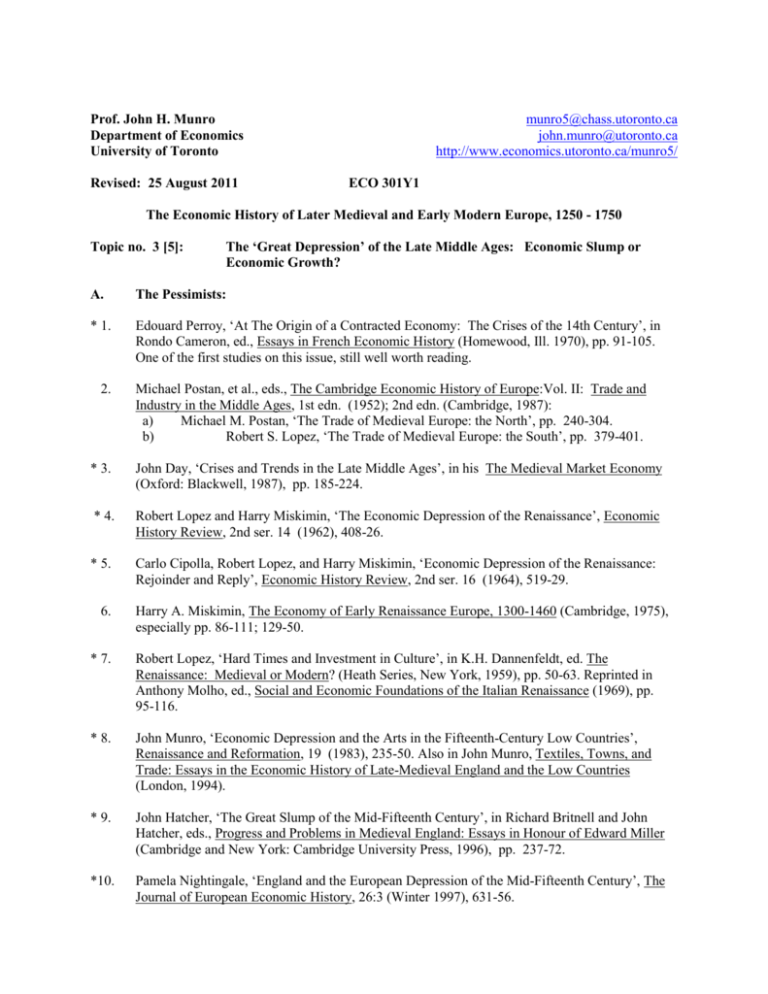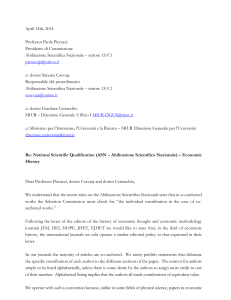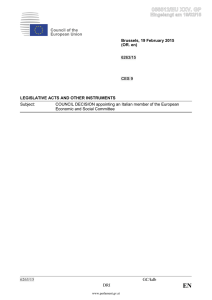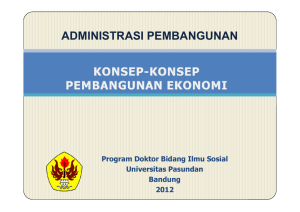MS-Word - Department of Economics
advertisement

Prof. John H. Munro Department of Economics University of Toronto Revised: 25 August 2011 munro5@chass.utoronto.ca john.munro@utoronto.ca http://www.economics.utoronto.ca/munro5/ ECO 301Y1 The Economic History of Later Medieval and Early Modern Europe, 1250 - 1750 Topic no. 3 [5]: The ‘Great Depression’ of the Late Middle Ages: Economic Slump or Economic Growth? A. The Pessimists: * 1. Edouard Perroy, ‘At The Origin of a Contracted Economy: The Crises of the 14th Century’, in Rondo Cameron, ed., Essays in French Economic History (Homewood, Ill. 1970), pp. 91-105. One of the first studies on this issue, still well worth reading. 2. Michael Postan, et al., eds., The Cambridge Economic History of Europe:Vol. II: Trade and Industry in the Middle Ages, 1st edn. (1952); 2nd edn. (Cambridge, 1987): a) Michael M. Postan, ‘The Trade of Medieval Europe: the North’, pp. 240-304. b) Robert S. Lopez, ‘The Trade of Medieval Europe: the South’, pp. 379-401. * 3. John Day, ‘Crises and Trends in the Late Middle Ages’, in his The Medieval Market Economy (Oxford: Blackwell, 1987), pp. 185-224. * 4. Robert Lopez and Harry Miskimin, ‘The Economic Depression of the Renaissance’, Economic History Review, 2nd ser. 14 (1962), 408-26. * 5. Carlo Cipolla, Robert Lopez, and Harry Miskimin, ‘Economic Depression of the Renaissance: Rejoinder and Reply’, Economic History Review, 2nd ser. 16 (1964), 519-29. 6. Harry A. Miskimin, The Economy of Early Renaissance Europe, 1300-1460 (Cambridge, 1975), especially pp. 86-111; 129-50. * 7. Robert Lopez, ‘Hard Times and Investment in Culture’, in K.H. Dannenfeldt, ed. The Renaissance: Medieval or Modern? (Heath Series, New York, 1959), pp. 50-63. Reprinted in Anthony Molho, ed., Social and Economic Foundations of the Italian Renaissance (1969), pp. 95-116. * 8. John Munro, ‘Economic Depression and the Arts in the Fifteenth-Century Low Countries’, Renaissance and Reformation, 19 (1983), 235-50. Also in John Munro, Textiles, Towns, and Trade: Essays in the Economic History of Late-Medieval England and the Low Countries (London, 1994). * 9. John Hatcher, ‘The Great Slump of the Mid-Fifteenth Century’, in Richard Britnell and John Hatcher, eds., Progress and Problems in Medieval England: Essays in Honour of Edward Miller (Cambridge and New York: Cambridge University Press, 1996), pp. 237-72. *10. Pamela Nightingale, ‘England and the European Depression of the Mid-Fifteenth Century’, The Journal of European Economic History, 26:3 (Winter 1997), 631-56. *11. Pamela Nightingale, ‘Monetary Contraction and Mercantile Credit in Later Medieval England’, Economic History Review, 2nd ser. 43 (Nov. 1990), 560 - 75. 12. James Masschaele, ‘The Renaissance Depression in Debate: The View from England’, The History Teacher, 27:4 (August 1994), 405-15. *13. William P. Caferro, ‘Warfare and Economy in Renaissance Italy, 1350 - 1450’, Journal of Interdisciplinary History, 39:2 (Autumn 2008), 167-209. 14. Charles F. Briggs, The Body Broken: Medieval Europe, 1300 - 1520 (London: Routledge, 2011). B. The Optimists: see Cipolla above, and the following: * 1. Carlo Cipolla, Robert Lopez, and Harry Miskimin, ‘Economic Depression of the Renaissance: Rejoinder and Reply’, Economic History Review, 2nd ser. 16 (1964), 519-29. Cipolla, only; Lopez and Miskimin are the leading pessimists whom Cipolla is challenging. 2. * 3. Wallace K. Ferguson, ‘Recent Trends in the Economic Historiography of the Renaissance’, Studies in the Renaissance, 7 (1960), 19-26. Reprinted in Anthony Molho, ed., Social and Economic Foundations of the Italian Renaissance (London and New York: Wiley, 1969), pp. 116 - 23. A.R. Bridbury, Economic Growth: England in the Later Middle Ages (1962), chapter 1 and conclusion in particular. An iconclastic study denying any contraction or slump. 4. E. Kosminsky, ‘Peut-on considérer le XIVe et le XVe siècles comme l’époque de la décadence de l’économie européenne?’ in Studi in onore di Armando Sapori, vol. I (Milan, 1957), pp. 55369. * 5. E. M. Carus-Wilson, ‘The Woollen Industry’, in M. M. Postan and Edward Miller, eds., The Cambridge Economic History of Europe, Vol. II: Trade and Industry in the Middle Ages, 2nd rev. edn. (Cambridge, 1987), pp. 614-90. *6. Christopher Dyer, Standards of Living in the Later Middle Ages: Social Change in England c. 1200 - 1520 (Cambridge, 1989). Especially chapters 5-8. 7. E. S. Hunt & J. M. Murray, A History of Business in Medieval Europe, 1200 - 1550, (NY, 1999). 8. Bas J. P. van Bavel and Jan Luiten van Zanden, ‘The Jump-Start of the Holland Economy during the Late-Medieval Crisis, c. 1350 - c. 1500', The Economic History Review, 2nd ser., 57:3 (August 2004), 503-32. Not necessarily opposed to the ‘depression’ thesis for western Europe in general, but analyzing the case of Holland’s singular economic growth in this era. C. Other Viewpoints and Related Themes: on structural macro-economic changes, monetary structures, and living standards. 1. Thomas A. Brady, jr., Heiko O. Oberman, and James D. Tracy, eds., Handbook of European History, 1400-1600: Late Middle Ages, Renaissance and Reformation, Vol. I: Structures and Assertions (Leiden/New York/Cologne: E.J. Brill, 1994): the following two essays: a) Bartolomé Yun, ‘Economic Cycles and Structural Changes’, pp. 113-46. b) John H. Munro, ‘Patterns of Trade, Money, and Credit’, pp. 147-95. * 2. Herman Van der Wee and Theo Peeters, ‘Un modèle dynamique de croissance interseculaire du commerce mondiale, XIIe-XVIIIe siècles’, Annales: E.S.C., 25 (1970), 100-28. See the following: * 3. John Munro, ‘The “New Institutional Economics” and the Changing Fortunes of Fairs in Medieval and Early Modern Europe: the Textile Trades, Warfare, and Transaction Costs’, Vierteljahrschrift für Sozial- und Wirtschaftsgeschichte, 88:1 (2001), 1 - 47. See also: John Munro, ‘Industrial Transformations in the North-West European Textile Trades, c. 1290 - c. 1340: Economic Progress or Economic Crisis?’ in Bruce M. S. Campbell, ed., Before the Black Death: Studies in the ‘Crisis’ of the Early Fourteenth Century (Manchester and New York, 1991), pp. 110 - 48. 4. S. R. Epstein, ‘Regional Fairs, Institutional Innovation, and Economic Growth in Late-Medieval Europe’, Economic History Review, 2nd ser., 47:3 (August 1994), 459 - 482. 5. Marian Malowist, ‘The Problem of Inequality of Economic Development in Europe in the Later Middle Ages’, Economic History Review, 2nd ser. 19 (1966), 15-28. Republished in French in his Croissance et régression en Europe, XIVe-XVIIe siecles (Cahiers des Annales no. 34, Paris, 1972), pp. 39-52. 6. Christopher Dyer, Standards of Living in the Later Middle Ages: Social Change in England c. 1200 - 1520 (Cambridge, 1989). Especially chapters 5-8. [Also listed in section B, above] *7. John H. Munro, ‘Wage-Stickiness, Monetary Changes, and Real Incomes in Late-Medieval England and the Low Countries, 1300 - 1500: Did Money Matter?’, Research in Economic History, 21 (2003), 185-298. *8. John Munro, ‘Builders’ Wages in Southern England and the Southern Low Countries, 1346 1500: a Comparative Study of Trends in and Levels of Real Incomes’, in Simonetta Caviococchi, ed., L’Edilizia prima della rivoluzione industriale, secc. XIII-XVIII, Atti delle “Settimana di Studi” e altri convegni, no. 36, Istituto Internazionale di Storia Economica “Francesco Datini” (Florence, 2005) pp. 1013-1076. The pdf file for this published version is available on my website, for Working Papers (no. 21): at http://www.economics.utoronto.ca/munro5/WorkingPapers.htm 9. Richard W. Unger, ‘Prices, Consumption Patterns and Consumer Welfare in the Low Countries at the End of the Middle Ages’, Jaarboek voor middeleeuwse geschiedenis, 8 (2005), 252-82. John Hatcher and Mark Bailey, Modelling the Middle Ages: The History and Theory of England’s Economic Development (Oxford and New York: Oxford University Press, 2001). *10. *11. Ian Blanchard, ‘The Late Medieval European ‘Integration Crisis’, 1340 - 1450’, in Troels Dohlerup and Per Ingesman, eds., New Approaches to the History of Late Medieval and Early Modern Europe: Selected Proceedings of Two International Conferences at the Royal Danish Academy of Sciences and Letters in Copenhagen in 1997 and 1999, Historisk-filosofiske Meddelelser 104 (Copenhagen: The Royal Danish Academy of Sciences and Letters, 2009), pp. 301-34. *12. Pamela Nightingale, ‘Gold, Credit, and Mortality: Distinguishing Deflationary Pressures on the Late Medieval English Economy’, The Economic History Review, 2nd ser., 63:4 (November 2010), 1081-1104. QUESTIONS: 1. Did the late-medieval European economy experience a secular downswing or ‘depression’ in the late Middle Ages? How would you define an economic contraction, downswing, or ‘depression’? Discuss the evidence pro and contra the ‘depression’ thesis. 2. If there was an economic contraction, what were its basic causes: exogenous or endogenous to the late-medieval European economy? What economic sectors were principally affected? What roles did demographic and monetary factors play in altering the late-medieval economy? 3. What role did warfare, and government (state) economic policies related to warfare and defence play in the economic crises or slump of the later Middle Ages? 4. What changes occurred in real incomes and standards of living in western Europe in this era? Who gained and who lost: in terms of regions, economic sectors, and social classes? And when? 6. What European countries or regions were principally affected by these structural economic changes? Did regional economic advances in some areas of Europe compensate for regional declines in other areas, during the 14th and 15th centuries?


